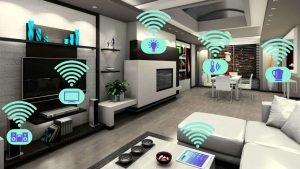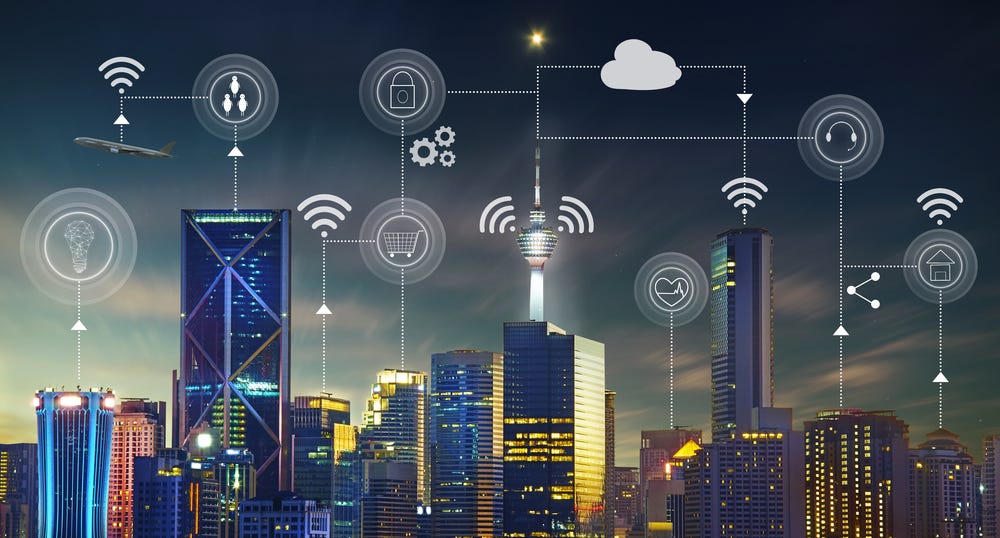Introduction to IoT in Smart Homes
In recent years, the concept of “smart homes” has become more than just a futuristic idea—it’s now a reality for many homeowners worldwide. At the core of this transformation is the Internet of Things (IoT), a network of interconnected devices that communicate with each other to make life easier, more efficient, and more comfortable. IoT technology allows smart devices to share data and respond to commands, creating an automated living environment that is intelligent, energy-efficient, and secure. From voice-controlled assistants to automated lighting systems, IoT is rapidly changing the way we live at home.
This article will explore how IoT is reshaping smart homes, its numerous benefits, and the exciting innovations that are making homes smarter than ever before.
The Role of Matter Standard in Enhancing Connectivity

One of the most significant barriers in creating a truly smart home has been the lack of interoperability between devices from different manufacturers. Homeowners often face challenges when trying to integrate smart devices like lights, thermostats, or security cameras, as these products sometimes use incompatible communication protocols.
This is where the Matter standard comes in. Matter, previously known as Project CHIP (Connected Home over IP), is an open-source, royalty-free connectivity standard that aims to improve the interoperability of smart home devices. Developed by major tech companies, including Apple, Amazon, Google, and others, Matter ensures that devices from different brands can work together seamlessly. This standard simplifies setup and enhances the user experience by eliminating the need for multiple apps and platforms.
Benefits of Matter:
- Unified control: Matter ensures that smart devices can work together, regardless of brand, allowing for centralized control.
- Faster setup: With Matter, homeowners can easily set up and connect devices without worrying about compatibility issues.
- Enhanced user experience: Matter streamlines interactions between different smart home ecosystems, making it easier for users to automate their homes.
Example: Imagine controlling your Amazon Alexa smart speakers, Apple HomeKit devices, and Google Nest products through a single app. With Matter, this is now a reality, allowing you to create a fully integrated smart home experience.
Energy Efficiency and Sustainability in Smart Homes
The push for sustainability and energy efficiency is another driving force behind the adoption of IoT in smart homes. Smart devices are designed not only for convenience but also for optimizing energy usage. With the help of IoT, homeowners can monitor and control their energy consumption, reducing their carbon footprint and lowering utility bills.
Smart Thermostats: One of the most popular examples of IoT in smart homes is the smart thermostat. Devices like the Nest Thermostat use sensors and machine learning to understand your habits and adjust the temperature in your home accordingly. These devices can even learn your schedule and optimize heating and cooling, ensuring that energy is not wasted when you’re away or asleep.
Smart Lighting Systems:
Another area where IoT is making a significant impact is lighting. Smart bulbs, such as Philips Hue, allow homeowners to adjust the brightness, color, and timing of lights. These bulbs can be controlled remotely or set to turn on and off based on specific conditions, such as when motion is detected or when the last person leaves the house. Additionally, they can be programmed to adjust according to the time of day, reducing energy usage and prolonging bulb life.
Benefits of Energy Efficiency:
- Cost savings: Optimizing energy use can lead to lower electricity bills.
- Environmental impact: Reducing energy consumption helps lower the carbon footprint.
- Convenience: Automated systems take the guesswork out of energy management.
Example: The Ecobee Smart Thermostat not only adjusts temperature based on occupancy but also provides real-time energy usage data, allowing homeowners to make smarter decisions about their energy consumption.
Revolutionizing Home Security with IoT
Home security has always been a priority for homeowners, and IoT is taking it to the next level. Traditional security systems were limited to alarms and motion detectors, but now, with IoT integration, smart security solutions provide more robust, real-time protection.
Smart Cameras and Doorbells:
Devices like Ring Doorbells and Nest Cam have revolutionized how we protect our homes. These smart cameras allow homeowners to monitor their property in real-time, whether they are at home or away. With features like motion detection, facial recognition, and two-way audio, these cameras not only help detect intruders but also provide a way to communicate with visitors or delivery personnel without opening the door.
Benefits of Smart Security:
- Remote monitoring: You can check live footage from anywhere using a smartphone app.
- Instant alerts: Receive immediate notifications if motion is detected or an intruder is spotted.
- Increased peace of mind: Knowing your home is monitored 24/7 helps ensure safety.
Example: The Arlo Pro camera system offers 4K video resolution, night vision, and two-way audio. It is equipped with AI-powered detection that can distinguish between people, animals, and vehicles, reducing false alarms.
Health and Wellness Features in Smart Homes

In addition to improving convenience and security, IoT devices are also enhancing the health and wellness of homeowners. Smart homes can now monitor various environmental factors such as air quality, temperature, and humidity, all of which can have a significant impact on health.
Indoor Air Quality:
Devices like Awair and Airthings track indoor air quality by measuring factors such as dust, CO2 levels, and humidity. Poor indoor air quality can lead to respiratory problems, allergies, and other health issues, but IoT-powered air quality monitors can alert homeowners to potential issues and recommend solutions, such as turning on air purifiers or opening windows.
Sleep Monitoring:
IoT can also help homeowners improve their sleep. Devices like the Sleep Number bed can track your sleep patterns and adjust firmness and support for optimal comfort. Additionally, smart lighting systems can mimic natural daylight patterns, helping to regulate sleep cycles and promote better rest.
Benefits of Health and Wellness:
- Improved air quality: IoT devices can monitor and manage indoor pollution, reducing health risks.
- Better sleep: Devices that adjust the environment can lead to more restful sleep.
- Personalized wellness: IoT systems learn individual preferences and provide tailored health solutions.
Example: The Dyson Pure Cool is a smart air purifier and fan that monitors indoor air quality and removes pollutants in real-time, offering cleaner, healthier air.
AI and Personalization in Smart Homes
Artificial Intelligence (AI) plays a pivotal role in making smart homes more intuitive and personalized. IoT devices with AI capabilities can learn from user behavior and adjust the environment accordingly.
Voice Assistants:
Voice-controlled assistants like Amazon Alexa, Google Assistant, and Apple Siri are powered by AI and can manage a wide range of smart devices. These assistants learn your preferences over time, allowing them to automate tasks such as adjusting the thermostat, controlling lighting, and even ordering groceries.
Personalized Automation:
AI-powered systems can adapt to your daily routines. For example, if you typically arrive home at 6 PM, the system will learn this and automatically adjust the thermostat and lights to your preferred settings before you even step through the door.
Benefits of AI and Personalization:
- Increased convenience: Automation reduces the need for manual adjustments.
- Time-saving: AI anticipates your needs, freeing up time for other activities.
- Enhanced user experience: Personalization creates a more comfortable, tailored living space.
Example: The Google Nest Hub uses AI to suggest actions based on your habits, such as adjusting the lights when you’re ready for bed or setting a reminder when it’s time to take medication.
Smart Homes and Integration with Smart Cities
The future of smart homes is not just about individual homes but also about the integration of smart technologies across entire communities. Smart cities, powered by IoT, are designed to enhance urban living through the interconnectivity of infrastructure, transportation, and public services.
Smart Grid and Utilities:
Smart homes are beginning to interact with the broader smart city infrastructure. For example, IoT-enabled smart grids can optimize electricity distribution, ensuring efficient energy use across entire neighborhoods. In some cases, smart homes can send energy data to the city grid, contributing to energy management efforts.
Traffic and Waste Management:
Smart homes also play a role in smart city initiatives. For example, IoT can optimize traffic flow by adjusting traffic signals based on real-time data, reducing congestion and pollution. Additionally, smart waste management systems can monitor waste levels and optimize collection routes.
Benefits of Smart Cities and Homes Integration:
- Improved efficiency: Smart city systems optimize resource usage on a large scale.
- Enhanced quality of life: Urban planning that includes smart homes leads to better living conditions.
- Sustainability: Smart cities promote sustainable practices through IoT-enabled systems.
Example: In Songdo, South Korea, a fully integrated smart city, residents’ homes are connected to city infrastructure, offering real-time updates on traffic, air quality, and waste management.
The Future of IoT-Driven Smart Homes

The future of IoT in smart homes looks incredibly promising. As technology advances, more devices will become smarter and more intuitive, and integration with other smart systems will become more seamless. With advancements in AI, machine learning, and edge computing, smart homes will be even more personalized and efficient in the years to come.
Conclusion: The Future Impact of IoT on Smart Homes
In conclusion, IoT is revolutionizing smart homes by providing greater connectivity, automation, and efficiency. From energy-saving devices to enhanced security and personalized experiences, IoT is making our homes more intelligent and responsive. The integration of IoT with smart cities and the rise of AI-driven automation will further enhance our living environments, ensuring that homes are not only more comfortable but also more sustainable and secure. As IoT technology continues to evolve, we can expect even greater innovations that will transform the way we live, work, and interact with our homes.




